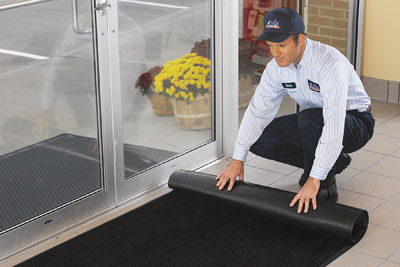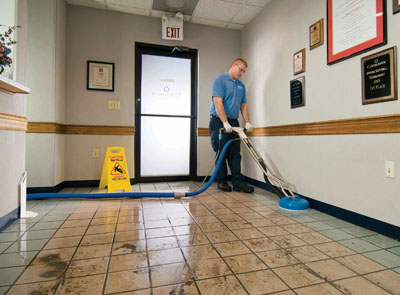Cintas
How to develop a floor maintenance program to boost customer loyalty.
In today’s uncertain economy, it is important for retailers to make a strong and lasting first impression because unsatisfied customers will take their business elsewhere. Upon entering a store, one of the first things a customer notices is the floors — and dirty floors often result in lost business. In fact, in a recent Harris Interactive poll, 86% of U.S. adults responded that dirty floors would negatively impact their perception of a retail store.
Proper floor care allows retailers to create a strong first impression while creating additional benefits. For example, integrating a mat system protects customers from slips and falls to generate trust and save retailers from costly lawsuits. Regular maintenance also extends the life of flooring, which reduces interruptions to business operations and costs associated with replacing floors. Above all, maintaining a clean and safe retail environment helps establish customer loyalty.
Develop an Ongoing Maintenance Program
To enhance the image of your business, add years to the life of floors and protect from slips and falls, it’s important to implement a floor maintenance program. A comprehensive floor maintenance program includes three key steps: protect, maintain and deep clean.
 Protect. The first step to prolong flooring life is to implement a comprehensive mat system. Floor mats capture dirt and liquids as people enter and walk through your store, keeping a facility clean and reducing maintenance costs. They can also assist in keeping customers and employees safe from slips and falls. The National Safety Council reported that more than 9 million disabling slips and falls occur each year and cost retailers an average of $20,953 per claim. Mats reduce the amount of particulates and water to create a safe environment for customers and encourage public trust.
Protect. The first step to prolong flooring life is to implement a comprehensive mat system. Floor mats capture dirt and liquids as people enter and walk through your store, keeping a facility clean and reducing maintenance costs. They can also assist in keeping customers and employees safe from slips and falls. The National Safety Council reported that more than 9 million disabling slips and falls occur each year and cost retailers an average of $20,953 per claim. Mats reduce the amount of particulates and water to create a safe environment for customers and encourage public trust.
According to the Institute of Industrial Launderers, 80% of dirt is tracked into a building from outside. Therefore, the essential first line of defense is to have maximum coverage at entrances to absorb contaminants, including dirt and water. To enhance the effectiveness of entrance mats, place scraper mats outside to serve as a dual-mat system. In addition to entryways, high-risk zones represent areas where customers are at an elevated risk of slips and falls. High-risk zones include areas surrounding produce watering stations or drinking fountains where floors are often slippery. Strategic mat placement reduces slips and falls in high-risk zones to keep customers safe. High-traffic zones, such as hallways and corridors, experience a high level of foot traffic and should also be protected. In the retail setting, placing mats in these areas frees floors of contaminants and water while reducing wear patterns, which results in extended floor life and lower maintenance costs.
Maintain. Retailers must clean floors on a daily basis to protect and extend the life of the floor. This can be accomplished by pairing clean tools, such as mops, with the right cleaning chemicals for different floor surfaces. Designate specific tools for different areas to prevent cross contamination between departments. This will ensure that mops used to clean restroom floors are not being used to clean entryways or common areas. Likewise, it’s imperative to use the right chemicals designed for your flooring. For instance, if an acid-based cleaner is used on a natural stone floor, it can severely etch and permanently damage the floor creating an unpleasant visual for customers.
Another critical factor when using chemicals is to apply the proper amount. Using too much chemical can leave residue, which results in dull looking floors. When the floor becomes wet again, the excess chemical will make the floor slippery, causing a hazard for slips and falls. Chemical dispensing systems help reduce the opportunity for user error by ensuring that the right amount of floor cleaner is used every time to optimize cleaning efficiency.
 Deep Clean. To extend the life of flooring, retailers should invest in periodic deep cleaning services to remove dirt, break down buildup and extract all contaminants from grout lines, tile and carpeted areas throughout the building. Customers expect clean floors, but traditional methods fail at restoring the condition of floors and after constant foot traffic, floors quickly become worn. Deep cleaning with greater heat, pressure and extraction removes more dry particulate soil than any other method. It’s an essential practice for grout and tile as different greases and soil gradually build up on the surface. Carpets also benefit from hot-water extraction technology because it pulls out all of the dirt and contaminants that would otherwise stick to fibers and wear it down.
Deep Clean. To extend the life of flooring, retailers should invest in periodic deep cleaning services to remove dirt, break down buildup and extract all contaminants from grout lines, tile and carpeted areas throughout the building. Customers expect clean floors, but traditional methods fail at restoring the condition of floors and after constant foot traffic, floors quickly become worn. Deep cleaning with greater heat, pressure and extraction removes more dry particulate soil than any other method. It’s an essential practice for grout and tile as different greases and soil gradually build up on the surface. Carpets also benefit from hot-water extraction technology because it pulls out all of the dirt and contaminants that would otherwise stick to fibers and wear it down.
Five key elements must be present in your cleaning methodology to achieve a true deep clean for carpets and hard surfaces: temperature, agitation, chemical, time and extraction. Deep cleaning services are essential for retailers as continuous wear from customers and employees deteriorate the condition of floors resulting in an unpleasant environment for customers. By efficiently combining the five elements, retailers revive floors to their original state and achieve an unparalleled level of floor cleanliness.
Partner for Cost-Effective Success
To implement cost-effective yet customized programs, many retailers partner with a provider who has the expertise to handle specific flooring challenges. Service is a critical benefit of partnering with a provider. Professionals will visit your facility to replace mats and professionally clean them on a routine basis to maximize performance. This keeps mats from becoming overly saturated with contaminants that could potentially be tracked throughout your store by customers. Many retailers think vacuuming is a sufficient method to clean mats. However, according to Georgia State University, only 10% of dirt is removed from mats with a vacuum cleaner.
Likewise, retailers should partner with a provider to design and implement a preapproved emergency cleaning plan. In the retail environment, accidents and emergency situations may occur that are beyond the traditional knowledge and skill set of building managers. Improper cleaning of water damage, biohazards and broken products can result in permanent damage to floors and pose risks to customers, including slips and falls. Having an emergency preparedness plan ensures immediate and appropriate steps are in place to keep customers safe and protect floors.
Partnering with the right company also helps reduce much of the upfront cost associated with purchasing the proper equipment to deliver the best results. A service provider will arm your staff with the proper cleaning tools such as microfiber, dust and wet mops along with a chemical dispensing system to ensure the proper amount of chemical is used for every cleaning to maximize performance. Trained technicians will visit your facility on a routine basis to perform deep cleans. Many retailers find this option ideal because they do not have the proper equipment or trained staff to complete the task.
Implementing an ongoing floor maintenance program is a smart choice, especially during tough economic times. A comprehensive program enables retailers to prolong the life of flooring, protect from slips and falls and promote a strong first impression in a cost-effective manner. In addition, maintaining a clean retail environment with aesthetically pleasing floors will help retailers continue to attract and retain loyal customers to boost profit.
— Richard Doggett is senior director of strategic markets – retail for Cintas with more than 16 years of industry experience. Cintas Facility Services offers a wide range of solutions that enable businesses to build their image and increase profitability and productivity. The author may be reached at [email protected].
